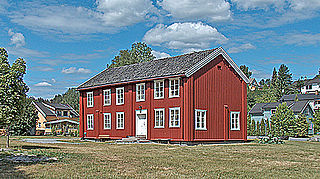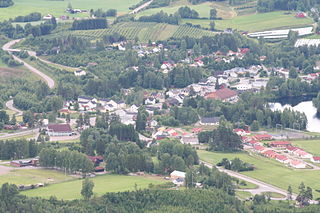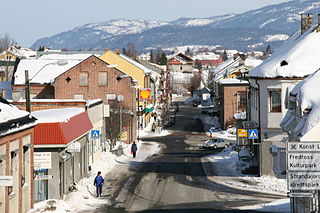Geithus is a village in Modum municipality of Buskerud, Norway. It is situated between the villages of Åmot and Vikersund. [1]

Modum is a municipality in Buskerud county, Norway. The administrative centre of the municipality is the town of Vikersund. The municipality of Modum was established on 1 January 1838.

Buskerud is a county in Norway, bordering Akershus, Oslo, Oppland, Sogn og Fjordane, Hordaland, Telemark and Vestfold. The county extends from the Oslofjord and Drammensfjorden in the southeast to Hardangervidda mountain range in the northwest. The county administration is located in Drammen. Together with Akershus and Østfold, Buskerud will form the new, larger county Viken, from 1 January 2020.
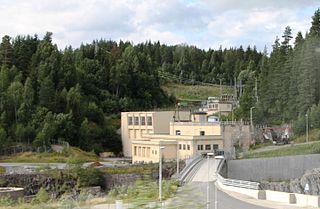
Åmot is a village in Modum municipality in Buskerud, Norway. Located just south of Geithus, the two villages have grown closer to each other. They have a combined population of 5,694.

Geithus is located where the southwestern arm of Tyrifjorden ends and drains into Drammenselva. Geithusbrua is a cable bridge, that spans the junction where Tyrifjorden turns into Drammenselva. There are two hydroelectric powerplants; Geithusfoss kraftverk and Gravfoss kraftverk. The area around Geithus in forested. Originally, there was an active pulp and paper industry in Geithus principally through the operation of Katfos Fabrikker. Production of paper, pulp and cellulose started in 1898. The operating was sold to Norske Skog Follum in 1970 and production stopped in 1983. [2] [3] [4]

Tyrifjorden is a lake in Norway. It lies 40 kilometres (25 mi) northwest of Oslo and is the nation's fifth largest lake with an area of 137 km2. It has a volume of 13 km3, is 295 meters deep at its deepest, and lies 63 meters above sea level. The lake's primary source is the Begna river, which discharges into Tyrifjorden at Hønefoss where the river forms the waterfall of Hønefossen. Its primary outlet is at Vikersund near the lake's southwest corner, where Tyrifjorden discharges into the Drammenselva river.
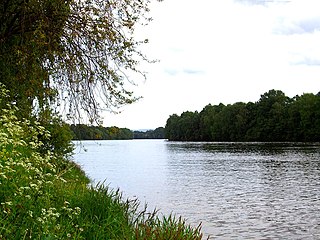
Drammenselva is a river in Buskerud county, southeastern Norway.

The pulp and paper industry comprises companies that use wood as raw material and produce pulp, paper, paperboard and other cellulose-based products.
There is a forty-minute trip to Drammen, and a little over an hour to Oslo. Until 2004, you could get to Geithus by train. Geithus rail station (Geithus stasjon) was built in 1875 as part of the Randsfjorden Line. Today it is closed, even though locals have demanded to get their station back. [5]

Oslo is the capital and most populous city of Norway. It constitutes both a county and a municipality. Founded in the year 1040 as Ánslo, and established as a kaupstad or trading place in 1048 by Harald Hardrada, the city was elevated to a bishopric in 1070 and a capital under Haakon V of Norway around 1300. Personal unions with Denmark from 1397 to 1523 and again from 1536 to 1814 reduced its influence, and with Sweden from 1814 to 1905 it functioned as a co-official capital. After being destroyed by a fire in 1624, during the reign of King Christian IV, a new city was built closer to Akershus Fortress and named Christiania in the king's honour. It was established as a municipality (formannskapsdistrikt) on 1 January 1838. The city's name was spelled Kristiania between 1877 and 1897 by state and municipal authorities. In 1925 the city was renamed Oslo.

The Randsfjorden Line is an 87-kilometre-long (54 mi) railway located in Buskerud in Norway connecting Drammen to Hønefoss and Hadeland in Oppland. The railway is primarily used for passenger trains, and the only scheduled trains on the stretch are Norwegian State Railways express trains on the Bergen Line between Oslo and Bergen. Freight trains to Bergen go to Hønefoss via the Gjøvik Line. The railway is owned by the Norwegian National Rail Administration.

